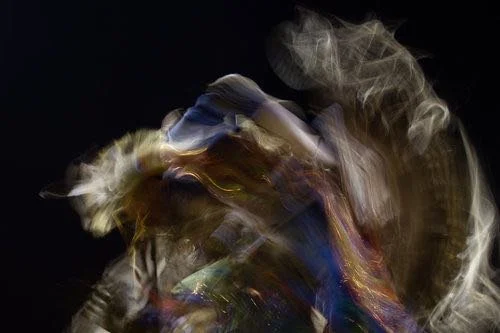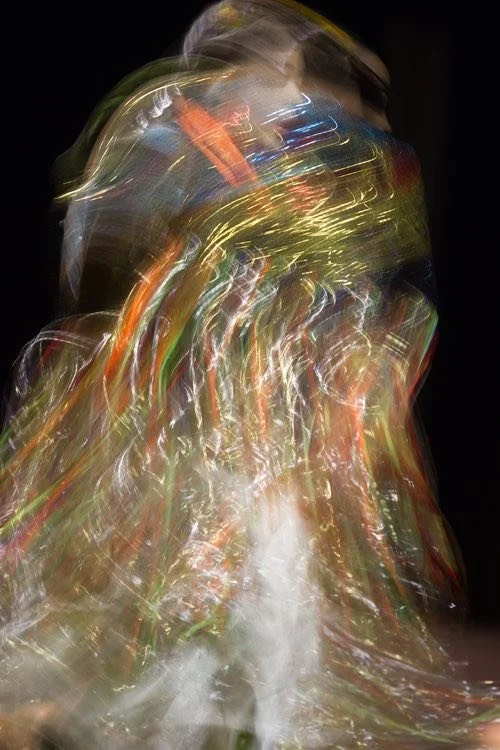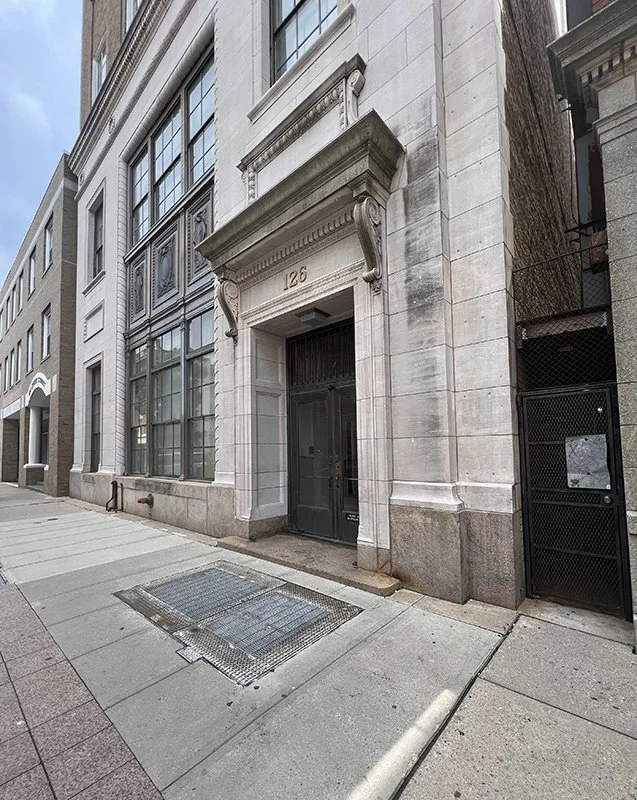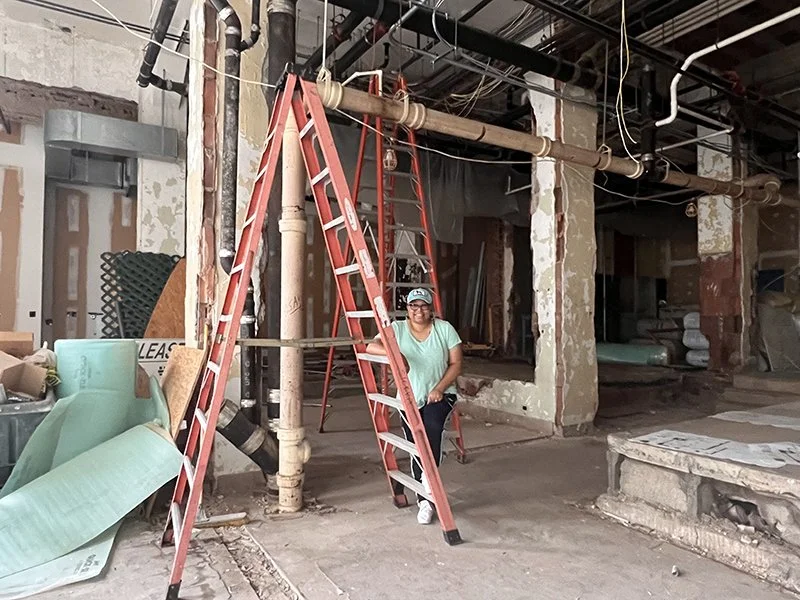Studio Visit | Kim Weston
Studio Visit | Kim Weston
Kamini Purushothaman
Kim Weston, from the series Layers of the Soul. Image from Kehler Liddell Gallery.
As a photographer, Kim Weston often explores “the things that we cannot see with our naked eye” using long exposure to capture motion, color, and community. Through a traditionally still art form—photography—she subverts expectations with her vibrant depictions of movement.
Currently, Weston is working on exploring both her Black and Native ancestry in her art. Her artistic process is particularly immersive. She usually photographs powwows, crouching down by the drums so she can feel the ground vibrate beneath her. In fact, she “shoots in rhythm,” feeling the drum beat as dancers sway in a circle.
“Once you’re in the circle,” she says, “you can kind of let everything go.” Because she uses long exposure, Weston doesn’t know how her photos will come out. This, too, is part of her process. What comes back, she says, is “what spirit wants me to see, what they allow me to capture.”
Sometimes she captures only a blur of color, and other times she’s left with a “person that has two faces going in different directions.” She feels that traditional dancing brings her closer to her ancestors, and her interest in motion mirrors her perspective on the afterlife. “When I think about the afterlife, and I think about life itself, it's constantly moving,” she says. “I think sometimes the afterlife dances in this life, and they kind of mend together, but we just can’t see it.”
To her, the afterlife “isn’t something that’s so far away,” but rather the energy that stays close to us. As such, her photographs often take on a metamorphic quality, with transient moments frozen in time.
Kim Weston, from the series Layers of the Soul. Image from Kehler Liddell Gallery.
As a young artist, Weston attended classes at the Jamaica Center for Arts & Learning in Queens, New York. There, she worked with Carrie Mae Weems, Dawoud Bey, and Lorna Simpson—artists she cites as her creative influences. She marvels at Simpson’s depictions of the Black body, naming this artist as one of her first inspirations. Weston values nuanced portrayals of people of color—something that is often lacking when depicted by white, male artists.
“What's curious to me,” she ponders, “is that white males have been going across America, South America, Asia, and Africa for hundreds of years with the camera and documenting various cultures, but from their lens, it always looks a little twisted, right?”
Instead, she admires artists like Priya Kambli, who immigrated to the United States at the age of eighteen with a single suitcase. In Kambli’s artwork, she explains, “There was no suffering. It was just ‘this is who we are’, you know, and ‘this is the color we use, and these are the things that we find precious’—no suffering, just regular life.”
Recently, Weston has been working to start Wabí Gallery, a diverse arts space that centers people of color in the New Haven community. Drawing from her time at the Jamaica Center, she plans to prioritize education and hire guest curators. She highlights the importance of curation, noting that while she could select pieces for the gallery herself, “having a real curator come in makes a huge difference.”
To Weston, the relationship between artist and curator is symbiotic, and the third party’s perspective is another way to diversify the gallery. She emphasizes that “curators of color are very aware that there are no images of themselves, or very few.” Those few depictions, Weston underscores, often place them in servantile roles or positions of pain. “For instance”, she adds, “paintings and images you will see at the Yale Center for British Art.” Particularly among younger curators, though, Weston is glad to have observed a strong desire to “deconstruct colonialism” in the art world.
Image courtesy of the author.
Perhaps Wabí Gallery is a step towards just that in New Haven. Weston named the gallery after the Algonquin word for “see,” choosing to honor her indigenous roots and acknowledge the Quinnipiac land New Haven was founded on. She is fascinated by how everyone perceives, or “sees” art differently based on their own experiences and identity. Including a wide range of perspectives is critical to Weston’s pursuit of creating an accessible space, and she plans to establish facilities like a bathroom, waiting area, and wheelchair access point to enter the gallery. She hopes to promote artists in New Haven while bringing in creatives from outside of Connecticut, like New York and Canada, encouraging an artistic cultural exchange of sorts in the gallery.
Weston wants to uplift the future generation of artists, too. For her, that starts with the FOCUS Fellowship, a photography program aimed at teenagers in New Haven. She recognizes that photography can be “a privileged kind of hobby” because of the costs of equipment. That sentiment, combined with her learning experience at the Jamaica Center, inspired her to create the free program “that high school students can be a part of to learn the craft of photography as an art or commercial form.”
The fellowship is set to start on October 11th and will run until June. Students will learn about fine art photographers, gain technical skills, and talk to local artists in New Haven. Because Weston believes renewability is crucial to promoting arts in the community, they will receive their own camera and equipment upon completion of the program so “they’ll be able to sustain themselves.” She plans to advertise the program through social media, word-of-mouth, and local publications.
To her, making art reachable and encouraging artists to know their worth are not mutually exclusive. She emphasizes that the gallery is for-profit: “We are who we are, right?” Weston reiterates the importance of supporting artists of color, saying, “Part of what Wabí stands for is educating the community on investing in art.”
Right now, the gallery is little more than a dusty room cluttered with ladders, cardboard boxes, and hanging wires. Weston is waiting on the finalization of a bank loan, but she has been planning the gallery’s layout with architect Eric Epstein, who came out of retirement to help.
When the space is finished, she envisions a performance space, collaborative offices with computers, and interior garage doors that give the gallery the potential for constant change. All that might be invisible now, but as Weston’s own art exemplifies, the unseen often reveals itself and the future is closer than meets the eye.
Image courtesy of the author.
All quotes are from an interview between the author and the artist on August 23, 2022, at Wabí Gallery.
Kamini Purushothaman
Kamini Purushothaman is a student living in New Haven who aspires to become a journalist. She enjoys going on walks around the city, her family’s annual visits to India, and creating artwork from found materials. Her interests include reading, writing, and visual arts. She is also passionate about studying fashion through the lens of environmentalism, labor rights, and sustainability.







